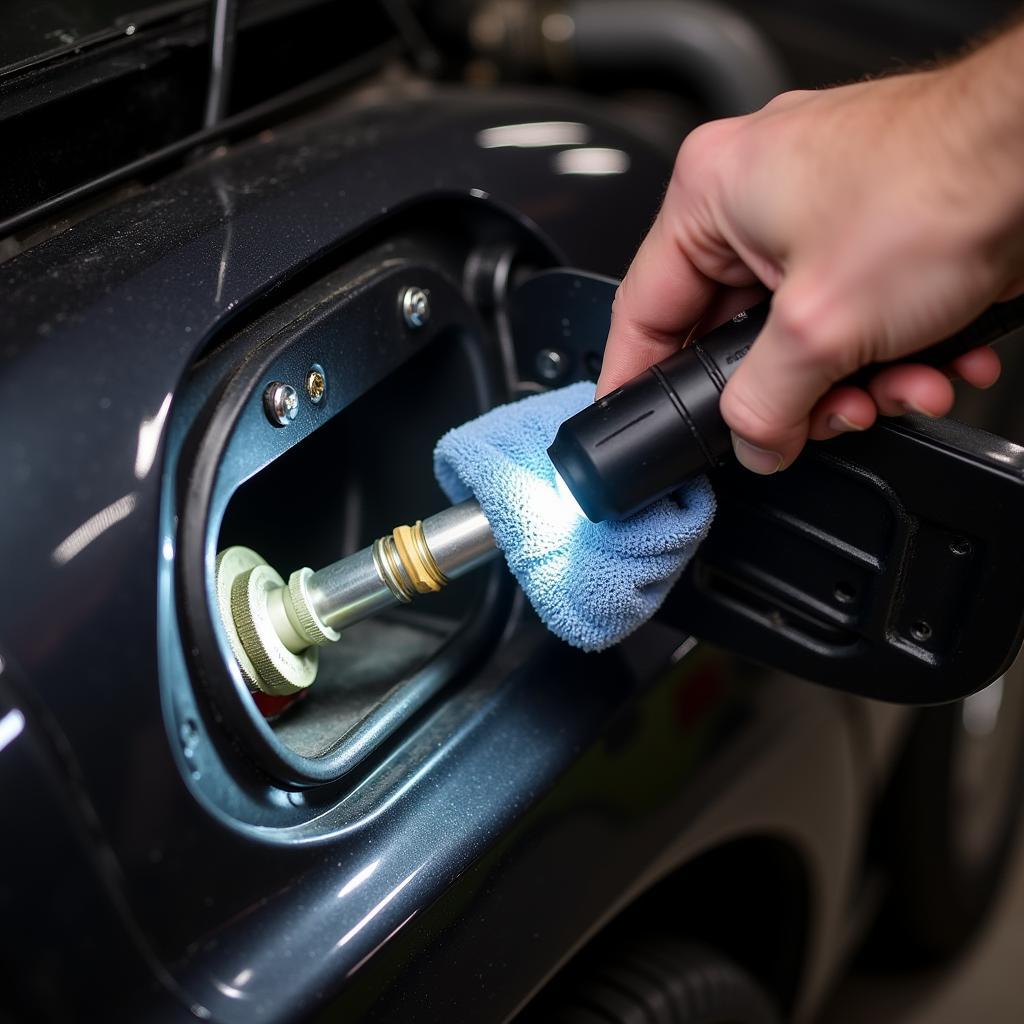A leaky fuel pump nozzle can be a real headache, leading to fuel waste, nasty smells, and even fire hazards. This guide will walk you through diagnosing and fixing a fuel pump nozzle leak, covering everything from simple checks to more complex repairs. We’ll empower you to tackle this issue head-on, whether you’re a seasoned mechanic or a DIY enthusiast.
Common Causes of Fuel Pump Nozzle Leaks
Before diving into solutions, let’s understand why these leaks occur. Common culprits include a damaged O-ring, a cracked fuel pump nozzle, or a loose fuel line connection. Sometimes, the issue isn’t the nozzle itself, but a faulty fuel pressure regulator causing excessive pressure and leading to leaks.
Diagnosing the Problem: Where’s the Drip Coming From?
Pinpointing the source of the leak is crucial. Is it dripping from the nozzle itself, or is it coming from the connection between the nozzle and the fuel line? A careful inspection, perhaps with a flashlight and a clean rag, will help you identify the exact location.
 Inspecting Fuel Pump Nozzle Leak
Inspecting Fuel Pump Nozzle Leak
Simple Fixes: Tighten and Replace
Sometimes, the solution is surprisingly simple. Check if the fuel line connection is loose and tighten it if necessary. If the leak persists, the O-ring might be the culprit. These rubber seals are inexpensive and easy to replace.
How to Fix a Fuel Pump Nozzle Leak: A Step-by-Step Guide
If the simple fixes don’t work, you might need to replace the fuel pump nozzle itself. Here’s a step-by-step guide:
- Relieve Fuel Pressure: This is crucial for safety! Disconnect the negative battery terminal and locate the fuel pressure test port (consult your car’s manual). Carefully release the pressure using a suitable tool.
- Disconnect the Fuel Line: Once the pressure is released, disconnect the fuel line from the fuel pump nozzle. Use a wrench and be careful not to damage the line.
- Remove the Fuel Pump Nozzle: The removal process varies depending on the car model, but it typically involves removing retaining clips or bolts. Consult your car’s service manual for specific instructions.
- Install the New Nozzle: Install the new fuel pump nozzle, ensuring it’s properly seated and secured. Replace the O-ring as well.
- Reconnect the Fuel Line: Carefully reconnect the fuel line and tighten it securely.
- Reconnect Battery and Test: Reconnect the negative battery terminal and start the engine. Check for leaks.
When to Call a Professional
While replacing a fuel pump nozzle is often doable for DIYers, sometimes the issue is more complex. If you’re unsure or uncomfortable with any of the steps, it’s best to consult a qualified mechanic.
“A small fuel leak can quickly become a big problem,” warns John Smith, ASE Certified Master Technician. “If you’re not 100% confident in your abilities, it’s always safer to seek professional help.”
Preventing Future Fuel Pump Nozzle Leaks
Regular maintenance is key to preventing fuel leaks. Inspect the fuel system periodically for any signs of wear or damage. Replace aging fuel lines and O-rings proactively. Also, avoid overfilling your tank, as this can put extra pressure on the fuel system.
Conclusion
Fixing a fuel pump nozzle leak can range from a simple fix to a more involved repair. By following this guide and taking the necessary precautions, you can effectively address this issue and keep your car running smoothly. If you need further assistance, feel free to connect with the experts at AutoTipPro. Our team is here to help! Call us at +1 (641) 206-8880 or visit our office at 500 N St Mary’s St, San Antonio, TX 78205, United States.
“Remember, safety first!” advises Jane Doe, Automotive Engineer. “Always relieve fuel pressure before working on the fuel system and never work near an open flame.”
FAQ
- What are the signs of a fuel pump nozzle leak? A strong fuel smell, visible fuel dripping, or a decrease in fuel efficiency can all indicate a leak.
- Can I drive with a fuel pump nozzle leak? It’s not recommended. A leak can create a fire hazard and damage other components.
- How much does it cost to fix a fuel pump nozzle leak? The cost varies depending on the car model and the extent of the damage. A DIY repair might cost under $50 for parts, while a professional repair could range from $100 to $300 or more.
- How often should I inspect my fuel system? It’s a good idea to inspect your fuel system at least once a year or as part of your regular maintenance schedule.
- What tools do I need to replace a fuel pump nozzle? You’ll typically need a wrench, screwdrivers, and a fuel pressure release tool. Consult your car’s service manual for specific tools.
- Is it difficult to replace a fuel pump nozzle myself? The difficulty varies depending on the car model. Some cars have easier access to the fuel pump than others.
- What should I do if I smell fuel but can’t find a leak? Take your car to a qualified mechanic immediately for a thorough inspection.





Leave a Reply